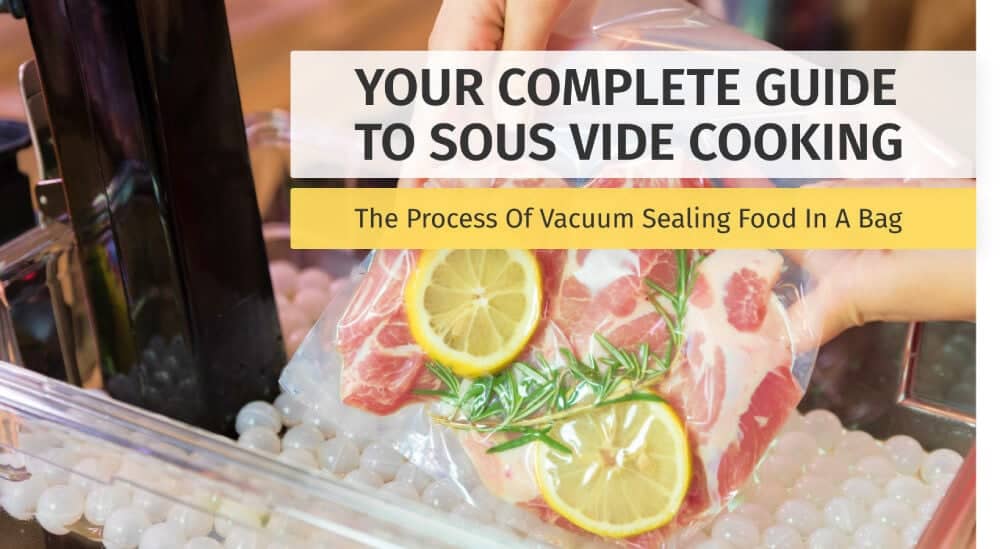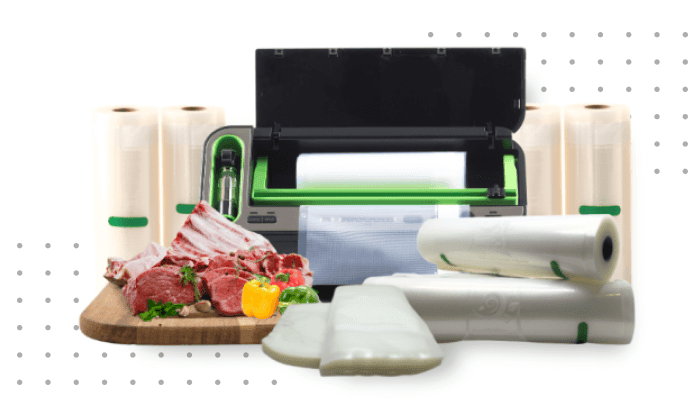Have you ever anticipated treating yourself to good home-cooked medium rare steak only to cut into it to find out you overcooked it? Using the sous vide method to cook next time will prevent you from feeling that way again.
Sous vide cooking allows you to have precise control over the texture and taste of your cooking. You can achieve consistent and repeatable results you wouldn't otherwise be able to attain using traditional cooking methods.
For foods that require expertise to cook to perfection, like steak, or vegetables you're afraid of overcooking like broccoli, sous vide cooking will make it easy for you to get right. With sous vide cooking, your food is cooked at a lower temperature over a longer time.
Read on to get all the information that you need about the sous vide technique.
What is Sous Vide Cooking?
Sous vide is French; its literal meaning is "under vacuum." It refers to a cooking technique where food is placed in a vacuum-sealed bag and cooked at a precise temperature in a temperature-controlled water bath.
Putting the food in a vacuum-sealed bag helps to lock in flavor and moisture lost when cooking foods with traditional methods. It also prevents the food from getting soaked with water during the cooking process.
The sous vide method drastically reduces the risk of overcooking. This is because you can control the heat and temperature at which the food is being cooked. It can cook food at a precise temperature for a long time without overcooking them.
Sous vide cooking also allows for even cooking of food. When cooking with a grill or a pan, the outside of the food cooks faster than the inside. With sous vide, the constant temperature of the water bath allows the food to cook uniformly.
It also helps eliminate all forms of guesswork involved in traditional cooking. You don't have to cut and peek at your steak or pork to see if it is done. You don't have to jab at a piece of meat to feel how tender it is or poke it with a thermometer. Once you set the temperature, food cooked sous vide will always cook to perfection.
TIPS: Top 17 Advantages to Vacuum Sealing Your Food
Sous Vide Cooking Equipment
Sous vide cooking might sound complicated, but it is not. You don't need overly sophisticated equipment or gadgets to get started. The basic equipment that you will require include;
1. Immersion Circulator
An immersion circulator is a device you insert into a pot or tub of water to heat it and keep it at a stable temperature. To get started, insert the heating coil and pump end of the circulator into the water. As the heating coil heats the water to the temperature you set, the pump circulates the water to ensure the heat is evenly distributed.
You don't need any other equipment to attach your immersion circulator to your container. They come with clamps that you can attach to any pot or container you own.
2. Vacuum Sealed Bags
This is where you put your meat, vegetable or whatever it is you want to cook before putting it in the water bath. It is important that you choose bags that do not contain BPA (Bisphenol A) and are food safe.
3. Container
This is where the water and already vacuum-sealed food will go. While any large pot you have will do, a Cambro plastic container is more suitable for sous vide as plastic is a better insulator.
Also, cooking with the sous vide method takes quite some time, making cooking in batches strenuous. You need to ensure your container is big enough to accommodate your vacuum bags while still leaving enough room for the water to circulate freely.
4. Binder Clips
Binder clips help to attach your bag to your pot or cambro container. They can also help you to keep the bag submerged under water for thorough cooking.
Other equipment you might need includes a cast iron skillet or blow torch for searing.
Choosing Sous Vide Cooking Bags
The bag you choose when cooking sous vide is essential to the success of your cooking. When cooking sous vide, you want to ensure that the bag you use seals tightly, prevents leakage and allows the even cooking of your food. There are various types of bags you can use for sous vide cooking, both single-use and reusable options. They include;
1. Silicone Bags
Silicone bags are very durable and cost-effective. They can be reused multiple times, and are thicker than the average plastic bags. This can make them harder to seal and cause your bag to float during cooking. They are also harder to manipulate, especially when leading them with food.
2. Plastic Bags
You can also use plastic bags for sous vide, once you have cleared that they are safe for cooking. They are thinner than silicone bags and easier to manipulate. Ziploc bags are examples of plastic bags you can use. If you're using Ziploc bags, it is important that you use the freezer bags, as the seal on thinner bags breaks and degrades when used for long cook times.
3. Vacuum Sealer Bags
For best results when cooking sous vide, use vacuum sealer bags. They provide the tightest seals and have the least chance of floating while cooking. Learn more why you should vacuum seal your food.
Sous Vide Cooking Method
Sous vide cooking is easier than you might think. You just need to take these simple steps:
- Attach your immersion circulator to your pot or Cambro container
- Set the time and preferred temperature most suitable for what you are cooking and level of doneness you want.
- Season your meat, pork chop or vegetables. Be careful to avoid over-seasoning.
- Vacuum-seal your food. If you are using Ziploc bags, seal your food using the displacement method. Confirm that your bag is watertight to avoid diluting the food's juice with water.
- Attach the bag to the pot's or container's side.
- Make sure that it is completely submerged
- After it is finished cooking, give it a quick sear in a cast iron skillet or grill it to give it that rich crust and crispy exterior.
TIPS: Can You Vacuum Seal Frozen Meat? Complete Guide to Store Meat
Sous vide cooking time and temperature
Different foods require different temperatures and time to cook perfectly. The temperature that gives your beef the right amount of tenderness and doneness is different from that of chicken. Below are charts you can use for reference.
Steak
| Doneness | Temperature Range (°F) | Temperature Range (°C) | Time Range |
| Rare | 120 - 128 | 49 - 53 | 45 minutes to 2½ hours |
| Medium Rare | 129 - 134 | 54 - 57 | 45 minutes to 4 hours |
| Medium | 135 - 144 | 57 - 62 | 45 minutes to 4 hours |
| Medium Well | 145 - 155 | 63 - 68 | 45 minutes to 3½ hours |
| Well Done | 156 and above | 69 and above | 1 to 3 hours |
Chicken Thighs
| Doneness | Temperature (°F) | Temperature (°C) | Time Range |
| Firm and very juicy | 150 | 66 | 1 - 4 hours |
| Tender and very juicy | 165 | 74 | 1 - 4 hours |
| Very tender | 165 | 74 | 4 - 8 hours |
Chicken Breasts
| Doneness | Temperature (°F) | Temperature (°C) | Time Range |
| Tender, juicy and served cold | 150 | 66 | 1 - 4 hours |
| Soft, juicy and served hot | 140 | 60 | 1½ - 4 hours |
| Juicy, tender, stringy and served hot | 150 | 66 | 1 - 4 hours |
| Juicy, firm, stringy and hot | 160 | 71 | 1 - 4 hours |
Vegetables
Most vegetables are sous vide cooked between 183°F and 185°F (84°C and 85°C). The timing is what differs.
| Vegetable | Time Range |
| Carrot | 45 - 55 minutes |
| Bell Pepper | 50 minutes |
| Frozen Peas | 15 minutes |
| Spring Onion | 30 minutes |
| Sweet Potato | 50 minutes |
| Cauliflower | 40 minutes |
Tips for getting the best sous vide results
1. Make sure that your vacuum-sealed bag is completely submerged in water. When your food isn't properly submerged, it leads to uneven cooking. The part of the food not properly submerged cooks differently from the rest of the food. It can also increase the risk of food getting contaminated by bacteria.
If your sous vide bag is floating, check for trapped air. Foods that are less dense than water also tend to float. To deal with this problem, attach a big binding clip to the bottom of the bag. Then put a heavy spoon at the mouth of the clip. The weight of the spoon should keep your bag submerged.
2. As cooking goes on, water evaporates from the container. This can cause you not to have enough water to last through the entire cooking period. To prevent or minimise water loss through evaporation, cover your pot or container with a pot cover or plastic wrap.
You can also add ping-pong balls to the water bath. Ping-pong balls float and help to insulate your water bath. They also help the steam condense, consequently reducing the rate of evaporation.
3. Take note of the time. With regards to time, sous vide cooking is very forgiving but that doesn't mean you shouldn't consider time. Although your food will not overcook, the texture can change. Your food's texture changes more the longer it is exposed to heat.
4. Avoid over-seasoning. With traditional cooking methods like grilling or frying, some of the seasonings fall away during cooking. Not everything makes it onto the plate. With sous vide, however, because the food is trapped in the bag, inevitably all the seasoning ends on the plate.
You want to make sure that you go easy on the seasoning. Sous vide can take hours. There's nothing quite as painful as digging into your food after waiting all those hours to find that it's too salty.
5. If you are using the sous vide method to cook your meat, ensure that it is dry before searing it. The point of searing is to get that delectable crust that sous vide does not give. Searing wet cooked meat will not give you a crisp or crusty exterior.
Get A Vacuum Sealer and Vacuum Sealer Bags
Sous vide cooking is one of the ways to enjoy restaurant-quality meals even with home cooking. It's a less strenuous way of cooking and guarantees the best results.
Without a doubt, one of the most important steps while using the sous vide method is the vacuum sealing process. It has a significant impact on how well your food will turn out. The ideal way of scaling through this step is to use a vacuum seal bag and a vacuum sealer to ensure air and watertight seals time after time.
Visit our Outofair.com to get your durable and affordable vacuum sealer bags and sealers. Vacuum Sealer Bags & Rolls for Food Savers (Free Shipping)
Vacuum Sealer Bags & Rolls for Food Savers (Free Shipping)




Share this article: